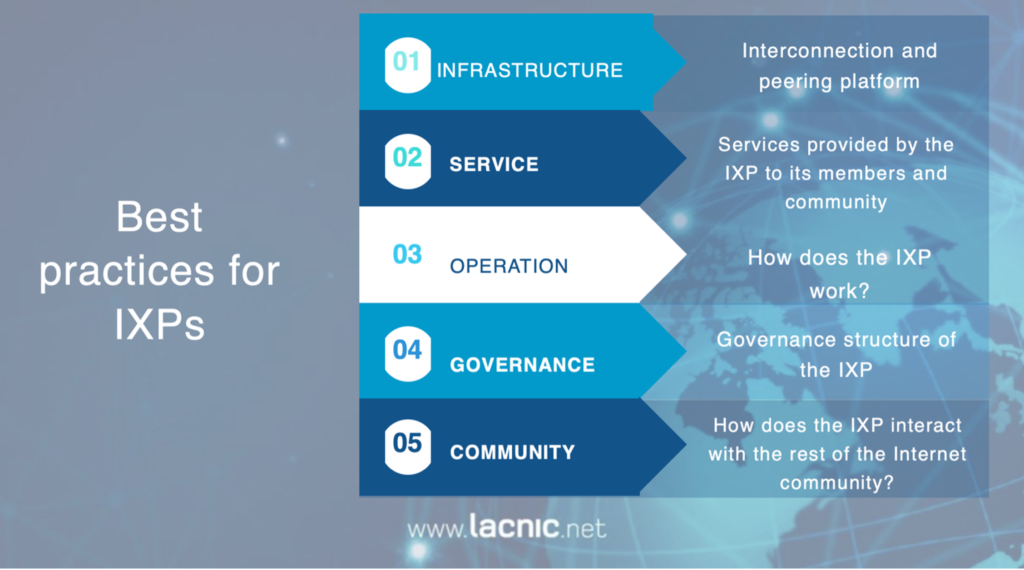As part of the Project for Strengthening Technological Capabilities in the Region, LACNIC, supported by SOCIUM.CR and LAC -IX, conducted a study on best practices observed in IXPs within the region. The study emphasizes operational, management, and procedural aspects intended as references, facilitating comparison with existing IXPs.
Our research focused on analyzing IXP strategies and approaches in search of best practices to improve the efficiency of Internet traffic exchange in the different regional Traffic Exchange Points.
We categorized our findings into five main areas: infrastructure, services, operations, governance, and community.
Resilience is considered a core value for IXPs. Typically, it is advantageous for an IXP to find in a co-location that can provide enhanced services such as redundant power sources, uninterrupted power supply (UPS), and backup generators. This significantly reduces downtime risks for the IXP.
It has been commonly observed that IXPs offer various services to their peers, possibly behind a separate AS Number. Any operator wishing to participate in an Internet Exchange must be assigned by a Regional Internet Registry (RIR) an Autonomous System number and a set of IP subnets. Without these elements, an operator would not be able to run BGP on their routers and consequently establish BGP exchanges with other members of the IXP.
SERVICE. This category considered the services provided by the IXP to its members and the community.
An essential aspect involves developing incident response protocols to manage potential eventualities.
Likewise, IXPs must offer statistics, which may include port traffic graphs, interconnection traffic views, interconnection matrices and, above all, provide information on their website about connection policies, prices and other topics of interest.
One good practice observed is connecting public entity services to local IXPs. This initiative not only encourages ISP participation but also offers citizens more reliable access to public services.
OPERATIONS. In this category, we emphasize recommendations on how IXPs work.
We believe it is vital to promote neutrality of IXP operations, ensuring zero discrimination in terms of who can connect to the Internet Exchange Point.
IXPs should actively support the growth of local content creators and service providers, while also implementing metrics to assess the promotion of local innovation.
Based on gathered experience, it is beneficial for an IXP to have its own Autonomous System (AS) and a small “service subnet,” primarily for monitoring and resolving issues effectively. From its AS, the IXP will announce its network, enabling it to host a website, email server, and possibly other services for its members.
If an IXP has a significant number of members with open peering policies, it may be useful to host a route server. Members with an open interconnection policy will only need to connect to the route server to interconnect with each other. Route servers also represent a substantial improvement in terms of scalability. The number of required BGP sessions in a full mesh grows quadratically with the number of members.
Implementing route servers reduces this complexity to a much more scalable linear function.
Typically, IXPs monitor traffic statistics for each port and add them all up to provide comprehensive insights. This is useful for observing Internet traffic trends and patterns at the IXP and, occasionally, for identifying issues. IXP Manager is a recommended tool for managing the IXP, particularly for new, small and medium-sized IXPs.
GOVERNANCE AND COMMUNITY. Within these categories, we identified a range of best practices for the governance of IXPs and their engagement with the Internet community.
In terms of governance, we highlight transparency, commitment, fairness, and inclusivity as key values to guide decision-making processes. As a recommendation, we believe it is important for IXPs to rely on decentralized and multi-stakeholder ecosystems and to foster collaborative and cooperative approaches.
Finally, in the community category, we note a best practice where IXPs increasingly engage in local and regional forums, promoting networking and enhancing the resilience and growth of the services offered by the IXP.
Furthermore, we find it beneficial to encourage all access and content providers in each country to engage in community-driven discussions about peering, interconnection, and IXPs.
We invite you to visit the site for more detailed information on each category and references to recommended practices.

